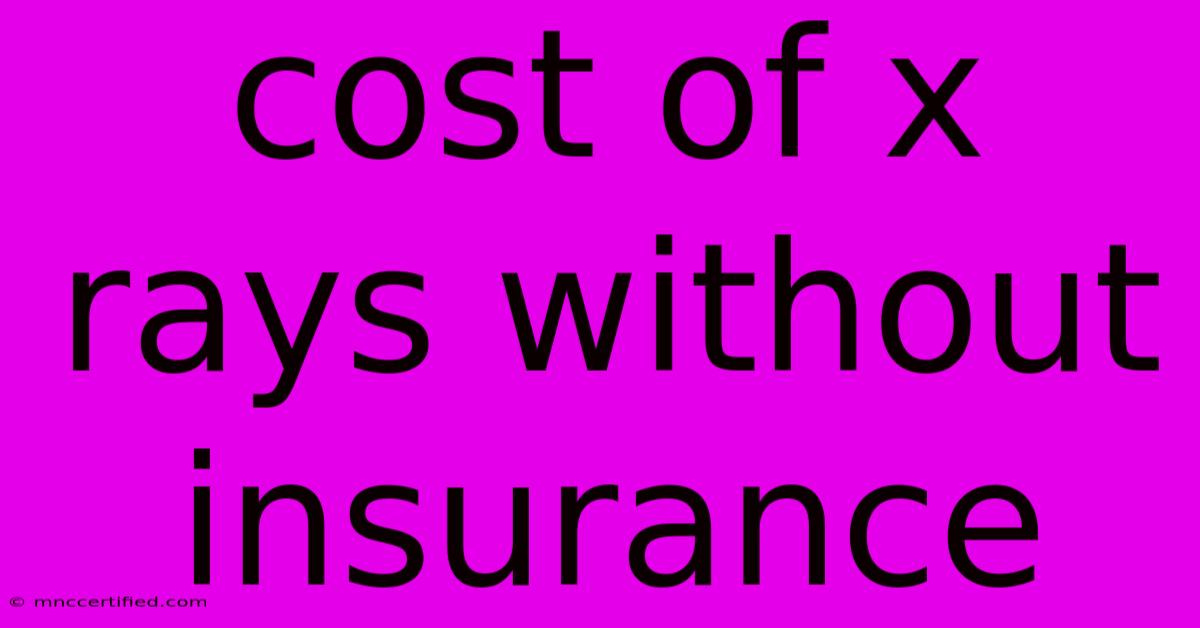Cost Of X Rays Without Insurance

Table of Contents
The Cost of X-Rays Without Insurance: A Comprehensive Guide
Getting an X-ray without insurance can be a surprisingly expensive undertaking. The cost varies wildly depending on several factors, and understanding these factors is crucial before you schedule your appointment. This guide will break down the cost of X-rays without insurance, helping you navigate the process and potentially save money.
Factors Affecting the Cost of X-Rays Without Insurance
Several key factors influence the final price tag of an X-ray when you don't have insurance coverage:
1. Type of X-Ray:
The type of X-ray significantly impacts the cost. A simple chest X-ray is generally less expensive than a more complex procedure like a CT scan (although a CT scan is technically a different type of imaging). Other factors include:
- Dental X-rays: These typically cost less than medical X-rays.
- Bone X-rays (e.g., hand, wrist, foot): These are usually less expensive than larger area X-rays.
- Abdominal X-rays: These tend to be more expensive due to the larger area covered.
2. Location:
The geographic location plays a significant role. X-ray costs in major metropolitan areas are often higher than those in smaller towns or rural settings. The specific facility also matters; hospital-based radiology departments tend to charge more than freestanding imaging centers or clinics.
3. Facility Type:
As mentioned above, the type of facility where you receive the X-ray influences the price. Hospitals usually have higher overhead costs, leading to higher charges. Independent imaging centers and clinics may offer more competitive rates.
4. Additional Services:
The total cost can increase if additional services are required, such as:
- Physician interpretation: Radiologists need to interpret the images. The fee for this interpretation is often added to the X-ray cost.
- Contrast media: Some X-ray procedures require contrast dye, significantly increasing the expense.
Estimating the Cost: What to Expect
Without insurance, a simple X-ray (like a chest X-ray) could cost anywhere from $100 to $500, depending on the factors listed above. More complex X-rays can easily exceed $1000. It's essential to contact the imaging center directly to obtain a price quote before your appointment to avoid unexpected bills.
Pro Tip: Always ask for a detailed itemized bill, specifying the costs of the X-ray itself, the radiologist's interpretation, and any other charges.
Ways to Reduce the Cost of X-Rays Without Insurance
Several strategies can help mitigate the expense:
- Shop around: Call several imaging centers in your area to compare prices.
- Negotiate: Some facilities may be willing to negotiate prices, especially for cash payments.
- Consider a payment plan: Many facilities offer payment plans to make the cost more manageable.
- Check for financial assistance programs: Some healthcare providers offer financial assistance or payment plans for uninsured patients. Inquire about these options.
- Look for discount programs: Some companies offer discount programs for medical services. Check with your employer or community organizations.
Alternatives to Consider
If cost is a significant concern, you might consider alternative options, such as:
- Delayed care (if appropriate): If the X-ray isn't urgent, delaying the procedure might allow you to save money or explore other cost-effective solutions. This is crucial for elective procedures, however, urgent medical care should always be prioritized.
- Negotiating with the provider: Many providers are willing to work with patients facing financial hardship.
Conclusion
The cost of X-rays without insurance can be substantial. By understanding the factors that influence pricing and employing the strategies outlined above, you can better manage the expense and access the necessary medical care. Remember to always inquire about prices beforehand and thoroughly review your bill to ensure accuracy. Don't hesitate to ask questions and explore all available options to find the best solution for your needs.

Thank you for visiting our website wich cover about Cost Of X Rays Without Insurance. We hope the information provided has been useful to you. Feel free to contact us if you have any questions or need further assistance. See you next time and dont miss to bookmark.
Featured Posts
-
Does Insurance Cover Hgh Therapy
Nov 22, 2024
-
Fifth Tourist Dies Laos Methanol Poisoning
Nov 22, 2024
-
Jones Future Giants Or Elsewhere
Nov 22, 2024
-
Pamela Haydens Best Milhouse Moments
Nov 22, 2024
-
Smolletts Hate Crime Conviction Overturned
Nov 22, 2024